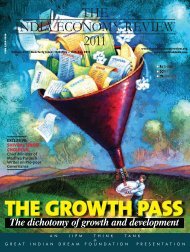Download - The India Economy Review
Download - The India Economy Review
Download - The India Economy Review
You also want an ePaper? Increase the reach of your titles
YUMPU automatically turns print PDFs into web optimized ePapers that Google loves.
Government. It had little power to dictate<br />
line departments and had no infrastruc-<br />
ture for independent assessment of re-<br />
sources although it was empowered to<br />
allocate funds for line departments of the<br />
Centre and also of the States. In pre-inde-<br />
pendent period the freedom fi ghters de-<br />
manded that the Union Government<br />
would receive one-fourth of the revenue<br />
collected by the States and the States<br />
would utilize the rest of the funds. Unfor-<br />
tunately, the ratio was reversed and the<br />
States were receiving only 25-30 % of the<br />
revenue. Fo the assessment of resources<br />
for human and material development, the<br />
Commission could utilize Panchayat and<br />
Nagar Palika for planning. This could only<br />
be done through participatory neighbour-<br />
hood survey by the people. Instead Plan-<br />
ning Commission and Planning Boards,<br />
across the nation, had to depend upon the<br />
secondary data provided by the line de-<br />
partment which was collected by employees<br />
and not by the people5 .<br />
<strong>The</strong> developmental plans and projects<br />
thus bound to be formulated from topdown<br />
manner and were implemented as<br />
directives. <strong>The</strong> recipient and the grass<br />
root implementers were seldom taken into<br />
confi dence. So, their participation became<br />
mechanical and casual.<br />
West Bengal Scenario<br />
<strong>The</strong> State Planning Board in West Bengal<br />
was formed in 19726 . <strong>The</strong> fi rst Planning<br />
Board undertook various activities in the<br />
fi eld of agriculture, irrigation, animal<br />
husbandry, forestry, industry, power,<br />
transport, science & technology, education,<br />
planning and miscellaneous. <strong>The</strong>se<br />
endeavours were not sustainable for the<br />
causes mentioned above. Planning from<br />
grass root was initiated in January 2002 on<br />
the basis of procedure prepared in 19857 .<br />
<strong>The</strong> modality is<br />
presented in modifi ed form which is<br />
as follows:<br />
1. Collection of data through participatory<br />
neighbourhood survey on :<br />
a. Human resources based on stratifi ed<br />
socio-economic status and gender<br />
Profi le.<br />
• Education, Employment & Health<br />
• Special participation of marginalised<br />
people (Scheduled Tribes, Scheduled<br />
Castes & Minorities) was solicited.<br />
b. Natural resource.<br />
• Land ( along with its character) i.e. cultivable,<br />
fallow, marshy & rocky etc.<br />
• Water resources of different types.<br />
• Forest – character with assessment of<br />
forest products.<br />
•<br />
•<br />
Shrubs – its scope of utilisation.<br />
Agricultural diversifi cation.<br />
c. Animal resources including situation &<br />
scope of improvement.<br />
d. Any other relevant information ob-<br />
2.<br />
tained during neighbourhood survey.<br />
Identifi cation of capabilities & effi -<br />
ciency of the local people to evaluate<br />
the available resources and their opti-<br />
mum utilisation. <strong>The</strong>y can prioritise for<br />
implementation from these informa-<br />
tions. People in the country were en-<br />
trusted to work out the following as-<br />
pects of development.<br />
3. Maximum utilisation & prioritisation<br />
of the resources through their own<br />
planning process.<br />
4. Assessment and optimisation of their<br />
own resources.<br />
T RANSFORMATIVE PLANNING<br />
5. Financial supports through Gram Sam-<br />
sads, Gram Panchayats, Zilla Parishads,<br />
State and National Schemes and other<br />
fi nancial agencies.<br />
<strong>The</strong> State Planning Board organised<br />
several meetings in twelve districts and<br />
discussed the principle and modality of<br />
planning from the grass root with threetier<br />
Panchayat system. A lot of enthusiasm<br />
was created but unfortunately this exercise<br />
could not be operationalised because<br />
Planning Board was only an advisory body<br />
and had little control over the line departments.<br />
Moreover, State Planning Board<br />
of <strong>India</strong> had no infrastructure of its own<br />
to conduct even a pilot study to collect<br />
primary data of resources and plan from<br />
the bottom.<br />
Department of Development and Plan-<br />
Planning Board had no infrastructure<br />
of its own to conduct even a pilot<br />
study to collect primary data<br />
ning undertook the task of preparing Human<br />
Development Report of the State<br />
involving State Planning Board. <strong>The</strong><br />
project was supported by UNDP. This<br />
exercise was done by collecting secondary<br />
data from different level of the administration.<br />
<strong>The</strong> informations were back dated.<br />
So, their effectivity for correction of<br />
the defi ciencies was limited.<br />
District Planning Committees (D.P.C.s)<br />
have constitutional authority. Here also<br />
planning virtually becomes disbursement<br />
of funds coming from State and Union<br />
government. <strong>The</strong> resource mapping at<br />
various levels was not done. Thus the exercise<br />
becomes mechanical and mostly<br />
beaurocratic. <strong>The</strong> elected members of<br />
D.P.C. are not trained for this exercise.<br />
<strong>The</strong> data is collected through National<br />
THE INDIA ECONOMY REVIEW<br />
83





